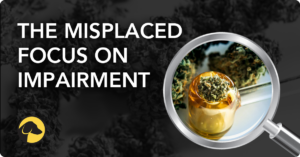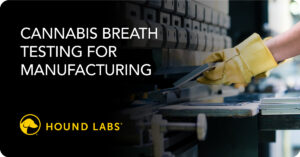
Fueling Progress: Adapting Cannabis Testing in the Energy Sector
The energy sector is a major player in global innovation and economics. And the industries comprising the energy sector – oil + gas, renewables, utilities, mining – are prominent end users of workplace drug testing. Employers leverage testing to promote safer work environments, recognizing that a single accident can have major safety, environmental, brand, and cost impacts.
Testing has historically been effective in deterring use in the energy sector, reflected by a low rate of workplace incidents. In fact, Mining (Oil and Gas) and Utilities reported the lowest number of non-fatal work injuries and illnesses in a 2022 report from the Bureau of Labor Statistics.
The longevity of this trend comes into question, however, as legalization makes cannabis more accessible to both applicants and employees. Increased use heightens safety concerns and increases incident risks. Studies emphasize the importance of continued testing in the legalization era, indicating that 53% of employers experienced an increase in workplace safety incidents when they stopped testing for THC.
The question, then, is not if energy employers should continue testing for cannabis, but how. Historically, energy employers have used conventional drug screens including oral fluid, urine, and hair to test for THC. With long windows of detection, these tests often identify the historical or ‘lifestyle’ use of drugs. In today’s environment, however, when many employees can use cannabis legally outside of work, it is more relevant for employers to isolate detection to the recent or ‘workday’ use of THC.
“Many employers want to ensure that employees are fit for duty when they show up to work and stay fit for duty throughout the workday,” says Robin Schelling, global substance prevention program leader for one of the world’s largest oil and gas operators. “The ultimate value of a workplace drug testing program is to keep employees safe from the impacts of drugs and alcohol in the workplace.”
As we explore this industry further, it’s evident that finding a middle ground between long-standing conservative practices and modern trends is a challenge, particularly regarding the evolving drug testing landscape. The solution is a recent use cannabis breath test that limits detection to a few hours, deters workday use, and promotes employee fairness.
ENERGY SECTOR SNAPSHOT
The energy sector covers the spectrum of getting energy to market, from extraction to transportation, and encompassing all the business operations in between.
Oil and natural gas play a pivotal role in the energy market, with a market size of more than $5.3 trillion in 2023, reports the Freedonia Group. This industry is responsible for supporting more than 41 million jobs worldwide, including 10.3 million jobs in the U.S. alone. In the United States, it accounts for 4.8% of the nation’s GDP, demonstrating its enormous economic impact.
Utility companies focus on providing electricity, water, and other public utilities. In 2022, utilities held a market capitalization of $1.58+ trillion. Renewable energy is expected to grow from 12% of the U.S. energy mix as of 2021 to 39% by 2030. Some of this growth is attributed to the Infrastructure Investment and Jobs Act, which earmarked $65 billion to upgrade the national power grid and expand clean energy efforts.
HARMONIZING TRADITION + INNOVATION
The sector operates within a dynamic landscape, constantly balancing long-established practices with the need to adapt to an ever-changing environment. It is impacted by a variety of factors, such as historical norms, market fluctuations, environmental obligations, and changing social expectations.
Regarding drug testing, they place great importance on complying with regulatory standards to maintain a positive reputation and adhere to rigorous testing protocols. For example, oil and gas companies often use lab-based urine testing and some even perform hair testing to make sure job applicants do not have any history of drug abuse – at least not in the past three months. Employers who have positions that fall under the Department of Transportation (DOT) are required to test in the manner that is prescribed by the specific agency – under which regulations testing is mandated. But even those who have DOT programs usually do a urine-expanded non-DOT test right alongside their DOT test.
As cannabis laws expand, energy employers face the delicate task of staffing enough qualified individuals and ensuring a safe workplace while respecting evolving regulations. If they continue THC testing using conventional methods, they may dissuade applicants concerned about being unfairly penalized for use outside of work. If they stop THC testing, they may open themselves to safety risks associated with use in the workplace.
MODERNIZING CANNABIS TESTING IN THE ENERGY SECTOR
Enter the HOUND® CANNABIS BREATHALYZER, representing a technological breakthrough in support of the energy sector’s THC testing programs. This innovative solution addresses the industry’s need for the accurate and efficient detection of recent cannabis use, specifically within the workday.
Here’s how it works and why it’s a game-changer:
- Precise detection: With a focus on the THC molecule itself, the HOUND® CANNABIS BREATHALYZER facilitates the accurate detection of recent cannabis use within a few hours of the test. This precision aligns with new employment protection laws, helping make cannabis testing fair and reliable.
- Short detection window: By isolating detection to use that occurs within 2-3 hours of the collection, employers maintain the risk avoidance benefits of testing.
- Observed collections: Individually packaged, single-use cartridges limit tampering and cheating. This approach enhances the credibility of the results.
- Data-driven test management: With an integrated results portal, employers have a paperless and efficient chain of custody and results management system. This wireless lab integration simplifies the entire collection and testing process.
A NEW STANDARD FOR TRADITIONAL EMPLOYERS
Maintaining a delicate balance between tradition and innovation is increasingly important for the energy sector when it comes to drug testing in the workplace, especially regarding cannabis use. By prioritizing workplace safety, employee fairness, and staying up-to-date with legal developments, the energy industry aims to navigate the complexities of workplace drug testing in the context of cannabis legalization.
The breakthrough technology of the Hound® solution offers a new standard for THC testing in the energy sector, fostering a safer and more reliable work environment for all. The precise and efficient detection of cannabis use, particularly within the workday, aligns seamlessly with the energy industry’s commitment to leveraging technology for enhanced safety protocols. With this innovative approach to cannabis testing, the energy sector can navigate the changing landscape while upholding its commitment to the well-being of its workforce and the broader community.
Contact Hound Labs today to learn more about how to implement the HOUND® CANNABIS BREATHALYZER as part of your organization’s future-forward drug testing program.

November 30, 2023
By SAMMIE DABBS
Chief Revenue Officer
Share











